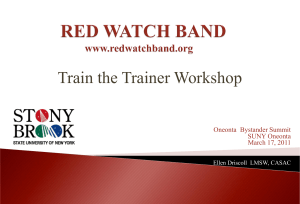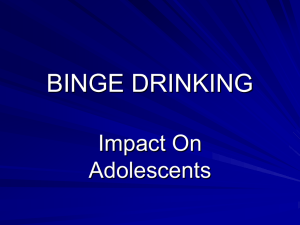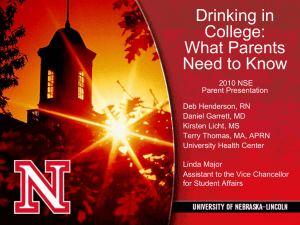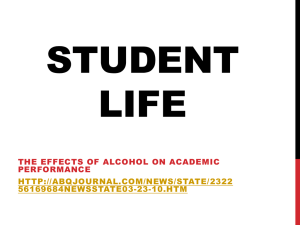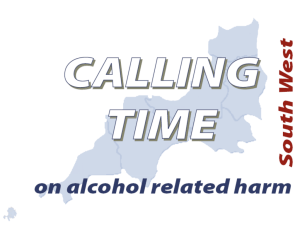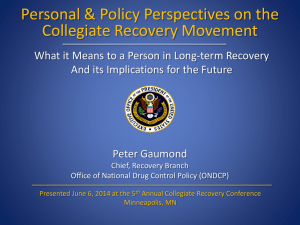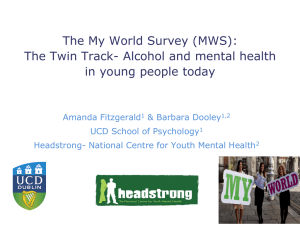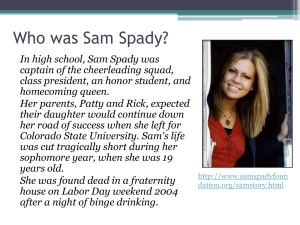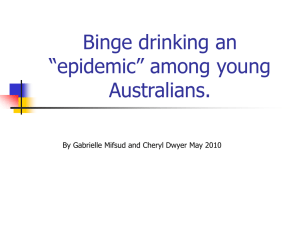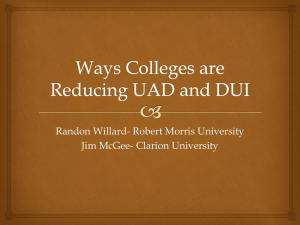TH-6.05 Red Watch Band - Bystander Intervention
advertisement
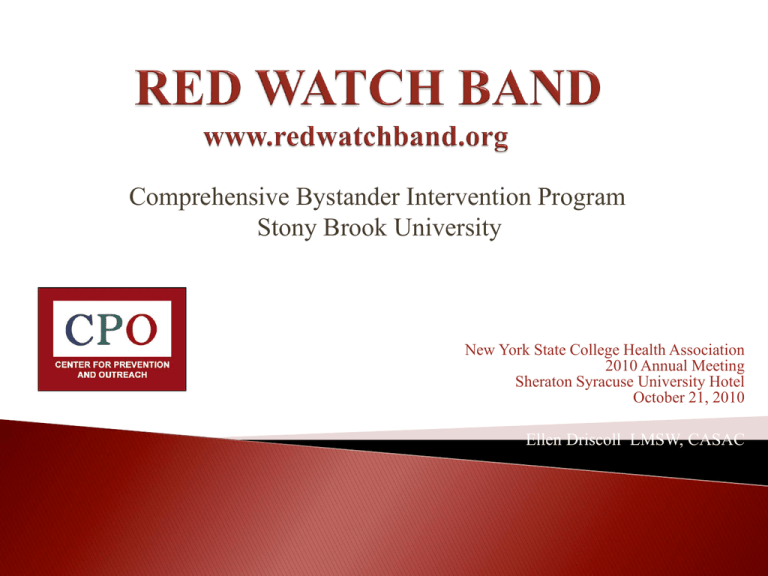
Comprehensive Bystander Intervention Program Stony Brook University Center for Prevention and Outreach NASPA January 2010 New York State College Health Association 2010 Annual Meeting Sheraton Syracuse University Hotel October 21, 2010 Ellen Driscoll LMSW, CASAC Comprehensive Bystander Wellness/Education program designed to prevent student death from TOXIC drinking The GOAL of the RED WATCH BAND is to ensure that all students are provided with accurate information about the dangers of alcohol use and know when, where and how to get help because every second counts. The MISSION of the RED WATCH BAND is to provide students with the knowledge, awareness, and skills to prevent toxic drinking deaths and to promote a student culture of kindness, responsibility, compassion, and mutual respect. Community Response to a Student Death Wellness/Educational Initiative Peer-based Intervention Program • Secondary Prevention Component Bystander Intervention Program • Alcohol Poisoning Death Prevention Knowledge & Skills Building RED WATCH BAND Challenging Myths Bystander Intervention Changing Drinking Culture Knowledge Self Awareness CPR Equates Alcohol Crisis to MEDICAL EMERGENCY Bystander Intervention Training Role Plays Death Prevention Decreasing Reluctance of Peers to Intervene (call 911) ◦ Don’t believe the situation is life threatening ◦ Don’t want to get friend/victim in trouble ◦ Don’t want to get themselves in trouble Changing Drinking Culture ◦ Tends to take form of binge/toxic drinking ◦ Binge drinkers are drinking more when they drink Don’t want to get the victim in trouble 4.21 Don’t want to get themselves into trouble 4.21 Don’t want to get others involved e.g. EMS or University Officials 4.05 They don’t believe the situation is life threatening 4.23 3.95 4.00 4.05 4.10 4.15 4.20 4.25 1 - Least Agreement ... 5 - Most Agreement Reasons for Attending RWB Training, n=40 National impact of college-age alcohol use: 1,825 college students between the ages of 18 and 24 die from alcohol-related unintentional injuries, including motor vehicle crashes. 599,000 students between the ages of 18 and 24 are unintentionally injured under the influence of alcohol. 97,000 students between the ages of 18 and 24 are victims of alcohol-related sexual assault or date rape. (Hingson et al., 2009) Binge drinkers are more likely than non-binge drinkers to: Damage property Be in trouble with campus police Be hurt or injured Drive a car after drinking (Harvard School of Health College Alcohol Study, 2000) How do your college students drink? ◦ Where? ◦ What? ◦ How Much? Definition of BINGE drinking ◦ 4+ drinks for women in approximately two hours ◦ 5+ drinks for men in approximately two hours Toxic Drinking STEP ONE: Student Engagement ◦ Student Leaders/Peer Educators STEP TWO: Collaboration of Key Stakeholders (on and off campus) ◦ Administration, Dept. chairs, Athletics STEP THREE: Design a Marketing strategy ◦ Communications Department for technical assistance STEP FOUR: Training Program ◦ CPR Training – American Heart Association ◦ Alcohol Emergency Education & Role Play STEP FIVE: Recognition of New Red Watch Band Members ◦ Sustainability ◦ Recognition and follow up I’m interested in knowing how to help my friends 4.48 I thought it would be helpful in my role on campus 4.35 I’m interested in CPR training 4.20 A friend recommended the training 3.43 I know friends who were involved in toxic drinking 3.08 I know friends who have problems with AOD 2.97 I know family who have problems with AOD 2.28 An RA (Resident Assistant) recommended it 1.55 I’ve experienced toxic drinking myself 1.21 1.00 1.50 2.00 2.50 3.00 3.50 4.00 4.50 5.00 1 - Least Agreement ... 5 - Most Agreement Reasons for Attending RWB Training, n=40 CPR and Role Plays They NEED to Know 1 - Least Agreement ... 10 - Most Agreement 5.00 4.80 4.60 Post 4.40 Post Post 4.61 Post Post 4.50 4.46 4.20 Post 4.62 4.50 4.46 4.00 Pre 4.08 3.80 3.60 3.40 Pre Pre 3.75 3.61 Pre 3.61 Pre 3.20 3.36 Pre 3.39 3.00 Toxic drinking and Alcohol OD Knowledge ID High Risk ID Facts and Myths ID Signs of a Life Environments and about sobering up Behaviors a friend threatening OD Responding to a Intervening in a toxic drinking toxic drinking emergency emergency n=40, p<0.05 Relevance Satisfaction Recommend to peer 80% Percentage of Participants 70% 60% 50% 40% 30% 20% 10% 0% Strongly Agree Agree Neutral Disagree Strongly Disagree n=40, p<0.05 Comprehensive Bystander Intervention Program designed to prevent death from toxic drinking. Adheres to best practices in prevention by encompassing education, peer education and community outreach. Widely commended by students. Since March 2009, over 2,260 students have been trained nationally. Described as “missing link” to prevention by university professionals. 115 colleges and universities have committed to implementing RWB at their respective institutions. High Schools have also begun implementing RWB. EVERY SECOND COUNTS… College Drinking: Changing the Culture - www.collegedrinkingprevention.gov Hazing Prevention - www.hazingprevention.org Higher Education Center - www.higheredcenter.org The Gordie Foundation – www.gordie.org National Institution on Drug Abuse - www.drugabuse.gov National Institute on Alcoholism and Alcohol Abuse of National Institute of Health - www.niaaa.nih.gov Substance Abuse and Mental Health Services Administration www.samhsa.gov NCAA Drug Testing Program - www.ncaa.org/wps/portal Alcoholics Anonymous - www.aa.org Adult Children of Alcoholics - www.adultchildren.org Al-anon - www.al-anon.org Anti-Hazing - www.stophazing.org Website: www.redwatchband.org Contact Person: Lara Hunter, LCSW Red Watch Band Program Coordinator Center for Prevention and Outreach Stony Brook University 631-632-6729
